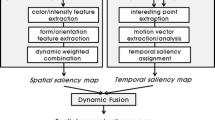Abstract
This paper proposes spatiotemporal volume saliency to detect and explore salient regions in time-varying volume data. Based on the center-surround hypothesis that the salient region stands out from its surroundings, we extend the spatial saliency to time domain and introduce temporal volume saliency. It is defined as a center-surround operator on Gaussian-weighted mean attribute gradient between steps in a scale-independent manner. By combing spatial saliency and temporal saliency together, our spatiotemporal volume saliency is effective in detecting changes of salient regions. We demonstrate its utility in this regard by automating transfer function design and selecting key frames for time-varying volume data.
Graphical abstract











Similar content being viewed by others
References
Ayala D, Campos J, Ferré M, Grau S, Puig A, Tost D (2005) Time varying volume visualization. Technical report
Bajaj CL, Pascucci V, Schikore DR (1997) The contour spectrum. In: Proceedings of visualization’97, pp 167–173
Itti L, Koch C, Niebur E (1998) A model of saliency-based visual attention for rapid scene analysis. IEEE Trans Pattern Anal Mach Intell 20(11):1254–1259
Jacobs DE, Goldman DB, Shechtman E (2010) Cosaliency: where people look when comparing images. In: Proceedings of the 23nd annual ACM symposium on user interface software and technology. ACM, New York, pp 219–228
Janicke H, Chen M (2010) A salience-based quality metric for visualization. Comput Graph Forum 29(3):1183–1192
Jankun-Kelly TJ, Ma KL (2001) A study of transfer function generation for time-varying volume data. In: Mueller K, Kaufman A (eds) Volume graphics 2001. Eurographics, pp 51–68
Ji G, Shen H-W (2006) Dynamic view selection for time-varying volumes. IEEE Trans Vis Comput Graph 12(5):1109–1116
Kim W, Jung C, Kim C (2011) Spatiotemporal saliency detection and its applications in static and dynamic scenes. IEEE Trans Circuits Syst Video Technol 21(4):446–456
Kim Y, Varshney A (2006) Saliency-guided enhancement for volume visualization. IEEE Trans Vis Comput Graph 12(5):925–932
Koch C, Poggio T (1999) Predicting the visual world: silence is golden. Nat Neurosci 2(1):9–10
Koch C, Ullman S (1987) Shifts in selective visual attention: towards the underlying neural circuitry. Springer, New York, pp 115–141
Lee CH, Varshney A, Jacobs DW (2005) Mesh saliency. ACM Trans Graph 24(3):659–666
Ma K-L (2003) Visualizing time-varying volume data. Comput Sci Eng 5(2):34–42
Machiraju R, Fowler JE, Thompson D, Soni B, Schroeder W (2001) EVITA-efficient visualization and interrogation of tera-scale data. Springer, New York, pp 257–279
Pfister H, Lorensen B, Bajaj C, Kindlmann G, Schroeder W, Avila LS, Raghu KM, Machiraju R, Lee J (2001) The transfer function bake-off. Comput Graph Appl 21(3):16–22
Wang CL, Yu HF, Ma KL (2008) Importance-driven time-varying data visualization. IEEE Trans Vis Comput Graph 14(6):1547–1554
Wang YH, Chen W, Zhang J, Dong TX, Shan GH, Chi XB (2011) Efficient volume exploration using the Gaussian mixture model. IEEE Trans Vis Comput Graph 17(11):1560–1573
Wang CL, Shen HW (2011) Information theory in scientific visualization. Entropy 13(1):254–273
Yu HF, Wang CL, Shene CK, Chen JH (2012) Hierarchical streamline bundles. IEEE Trans Vis Comput Graph 18(8):1353–1367
Zhao Q, Koch C (2013) Learning saliency-based visual attention: a review. Signal Process 93(6):1401–1407
Acknowledgments
This research is supported by the National Natural Science Foundation of China under Grant No. 61170157, the National Grand Fundamental Research 973 Program of China under Grant No. G2009CB72380, and the Scientific Research Founding Project of NUDT.
Author information
Authors and Affiliations
Corresponding author
Rights and permissions
About this article
Cite this article
Shen, E., Wang, Y. & Li, S. Spatiotemporal volume saliency. J Vis 19, 157–168 (2016). https://doi.org/10.1007/s12650-015-0293-y
Received:
Revised:
Accepted:
Published:
Issue Date:
DOI: https://doi.org/10.1007/s12650-015-0293-y




